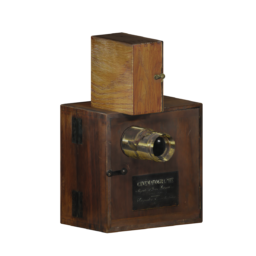Cinématographe

Cinématographe Podcast (5:57)
Note: Text in square brackets describes the soundscape as well as certain specific or occasional sounds.
[Aircraft ambience. We hear the ‘ding!’ of the seat belt sign]
Flight attendant: As we prepare to land in Paris, please return to your seats and fasten your seat belts.
[Theme music begins: soft piano melody]
Narrator: Wow! What a view…! When I was on the plane to Paris for my very first trip to Europe, I saw the amazing Eiffel Tower through the clouds. To immortalize this moment, I shot the scene from my window with my phone, without disturbing those around me. I pressed the record button and… there you go! One of the most beautiful views I have ever seen saved forever, thanks to the camera I carry around in my pocket.
I love shooting videos in my everyday life — but on vacation, it’s even more exciting! But how did the first filmmakers record their trips? Before the invention of the airplane, did travel films even exist?
[End of intro music]
[Sound effect of a boat on the ocean]
Narrator: After several long days crossing the ocean by boat, Alexandre Promio finally arrived in New York City, in September 1896.
[Occasional boat horn sound]
[Soft piano music begins]
Narrator: On his first visit to America, the French camera operator visited New York to shoot films – the very first films shot with a portable camera!
Invented by the Lumière brothers in 1895, this camera is named the Cinématographe. About the same size as a shoe box and about the same weight as four bags of milk, this lightweight camera allowed filmmakers like Mr. Promio to explore the world. Just like you and your phone, a Cinématographe camera operator could shoot images alone, without a crew.
But even if Mr. Promio travelled alone, he didn’t go unnoticed…
[Piano melody ends]
[Radio static sound. The quotation is read by the narrator, but her voice seems far away, as if it was one of the first recordings of the 1890s]
Narrator: “A swarm of journalists surrounded me […]. They came to ask me for details, and for portraits of Mr. Auguste and Mr. Louis Lumière and, as I had no copies, they put my face (taken at the hotel […] by a reporter) on the front page of the newspapers with this title: “The person in charge of the Cinématographe Lumière”. I couldn’t take a single step without being followed by a crowd that was eager to get caught in a scene, to then see themselves on screen.”
[Sound of Broadway Street in the 1890s: crowd talking, horses pulling carriages, car horns]
Narrator: As Mr. Promio frames streetcars and horse-drawn carriages on the famous Broadway Street, many curious pedestrians stop in front of his camera. Accustomed to attracting attention while filming, Mr. Promio continues his work.
[Streetcar passing]
Since the Cinématographe is set up on a heavy tripod and requires Mr. Promio to hold it with his hand while recording, neither he nor the camera can be moved while filming. Framing the image in a precise and thoughtful way is therefore very important. But since the Cinématographe Lumière does not have a viewfinder, how does he do it?
[Car horns]
To frame his image, Mr. Promio opens the Cinématographe and looks directly through the lens. Then, when he is satisfied, he loads the film and closes the camera. The filmmaker therefore cannot see what is being filmed. With a lot of practice and preparation, Mr. Promio memorizes the edges of his frame to understand which people and objects in front of him are entering and exiting his recorded images. Even without a viewfinder, Mr. Promio captures beautifully composed scenes!
The Cinématographe does not require electricity, but Mr. Promio must operate a crank handle at the back of the camera when he is ready to shoot. He notices a streetcar approaching him from a distance.
[Sound of the approaching streetcar]
Behind him, a horse-drawn carriage is about to enter the frame a few seconds after the streetcar passes.
[Horses footsteps getting louder]
The camera operator is ready: he turns the crank continuously for almost a minute. The 17-meter film reel gives him only 50 seconds of recording time!
[Bell ringing and keyboard chords over the sound of the crank]
[Beginning of playful music on the harpsichord that sometimes accompanies projections in 1896]
Narrator: Mr. Promio gets even more attention when, later that day, he uses the Cinématographe to project his recorded images onto a screen. Yes, you heard right!
[Sound of film passing through a projector]
After developing his film, the camera operator sets up the Cinématographe in front of a lantern and projects his film for an audience on the same day that the film was shot! This means that the Cinématographe is not only portable… but also doubles as a projector! Even in 1896, it was possible to share recorded images very quickly.
[Transition between harpsichord music from the 1890s and the sound effect of a plane landing. We hear a final ‘ding!’ from the seat belt sign and the distant voice of the flight attendant: ‘Bienvenue à Paris’]
[Theme music plays again]
Narrator: Who would have thought that the very first travel films are really not so different from my video of the Eiffel Tower…!
[Music stops]
To discover more cameras, listen to the other podcasts.